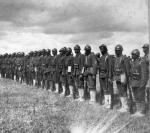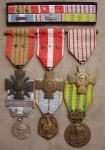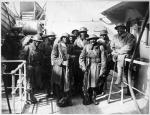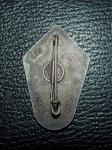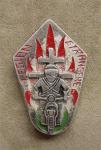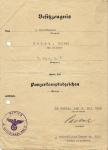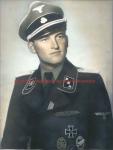-
Posts
2,284 -
Joined
-
Last visited
-
Days Won
6
Content Type
Profiles
Forums
Blogs
Gallery
Events
Store
Everything posted by PKeating
-
Colin, thanks for the kind words. I just do what comes naturally! Troublemaking, I mean... Ah, yes, "Dangermouse"! He shot himself in the foot with that one, didn't he? You could close your eyes and hear what was left of his cred on its way to the ocean via the sh1thouse pipes. I admit that I still get a grin out that too. Oh well, if I've managed to save a few people a few quid and that heartache that strikes when you realise you've been done, that's good enough for me. Fakers and their frontmen and shills are as bad as muggers. They are robbers. They steal from people. And then you have the dealers and collectors who rip off elderly people. That's as bad as posing as a gasman or something to get into some elderly person's flat and stealing their householding money. These people are typical of the kind of dealers behind the other two militaria websites. And then there are all those guys, the "historians" and "authors" who persuade veterans to hand over their photos and photo albums, which are then exploited for gain without any money going to the veterans or veterans organisations. Shining a light on that scam got me banned from the AHF. Interesting, isn't it, that for all the effort that goes into casting me as a sociopathic pariah, I have never had any trouble here on this website, despite occasional efforts by various shills with grudges. PK
-
Well, the militaria websites started off as promotional tools for bent dealers. Then we went through all the grief as "difficult" types posted truth. Truth didn't fly as far as the geeks running the two or three mainstream websites were concerned. Check my name on those sites: banned...expelled...excluded. I ain't the only one! Quite a few of us set out to tell it how it was...and we kept getting banned, deleted and so on. In the end, I think the majority of readers don't give a toss about what's real and what's not. If it shines, it's real...or as good as...right? There'll come a time soon when fakes from the 1960s and 1970s will be real! I look at the auction house lists these days and I see fake after fake...and I know who made this stuff. But nobody wants to hear truth... PK
-
Doesn't look too much like a shaver but I'd be a bit concerned by the fact that the core details are so rough and the frame halves look as though they've been prised apart. It could be a museum piece but, to be brutally frank, it strikes me as an artisanal attempt at making an 1813 EK2. PK
-
To some extent, perhaps. But I wouldn't argue with you just for the sake of being argumentative: I respect your intellect and breadth of knowledge too much for that! It was quite clear to me that you had more or, rather, have more than a passing interests in black soldiers throughout American military history. I think you are probably more knowledgeable than I am, because I have tended to focus on a couple of quite narrow topics within that history. Yes, indeed, I chose my words carefully! I avoided parrotting the claim and confined myself to remarking that the 369th "was said" to have been thus. Perhaps I should have used "alleged", but it would have seemed a bit odd. The 369th was also "said" to have been in the front line for the longest unbroken period of time spent on front line duty by any American unit in WW1: 191 consecutives days. Was this an exaggeration as well? I did not suggest that you said this. The Silver Citation Star (Inst. 1918) which was worn on appropriate service medal ribbons could perhaps be viewed as an American equivalent to the Croix de Guerre with Silver or Bronze Star but not the Croix de Guerre with Palm when awarded to a ranker for a single ground action. Comparisons are invidious, however, given the differing criteria between armies. It is probably fair to say that US awards - for whites at any rate - were easier won than equivalent awards for other Allied soldiers who had by then been at war for three years. Actions that brought, say, a British soldier a Military Medal at Loos might not have brought him the same degree of recognition by 1918. It was rather mean-minded of Champeny. He ought to have known better. Indeed it was. But not everyone overlooked the magnificent behaviour of the 9th and 10th Cavalry at San Juan Hill. Nor were the soldiers of the 24th Infantry overlooked. Even Teddy Roosevelt made a point at the time of giving them their due. His initial order for the assault on the hill was only heard by half a dozen soldiers anyway. Roosevelt had to turn back and muster a proper attack force, which only reached the Spanish positions towards the end of the battle. "There was very great confusion at this time, the different regiments being completely intermingled?white regulars, colored regulars, and Rough Riders.", said Roosevelt. Anyway, basically we agree when it comes to black soldiers in American military history. FYI, I have served with, served under and commanded black soldiers myself, albeit as a lowly corporal, and I can tell you that they tend to be as overlooked and disdained in British military history as in yours. It is something that has always rankled with me. I'm not black but I might as well have been as an Irish kid in London at the end of the 1960s! If nothing else, the Irish owe the West Indians and Africans from former British colonies quite a debt for taking the heat off us... Of course, it's cool to be Irish in Britain now. It's almost cool to be Black too. But I can't remember seeing any memorials to Black and Irish volunteers in the two World Wars. PK
-
I'm not putting words into your mouth, Dave. I'm merely expressing a logical interpretation of what you wrote. I don't know why this is becoming such an issue. I'm just trying to tell you how Frenchmen see it. Here's an extract from an article I wrote about Henry Johnson last year: According to just about every French military history buff and every French veteran I know, the general view is that a French enlisted man who was awarded the Croix de Guerre with Palm as a single award had received France's highest military award for bravery in the face of the enemy. The M?daille Militaire does not represent the same thing and nor does the L?gion d'Honneur. A CdG with Palm in one go is worth much more in terms of cachet than a CdG with Bronze or Silver Star or a M?daille Militaire, which was not generally awarded to grunts although it was awarded posthumously after WW1 to a number of enlisted KIAs and MIAs who had been awarded the CdG. Henry Johnson's action should have netted him at least a DSC at the time but no American awards were forthcoming until the 1990s. The French awarded him their highest available honour: the Croix de Guerre with Palm. Of the 2m or so CdG awarded from 1915 to 1918, I think you would find that relatively few involved awards to ground troops of the CdG with Palm at the same time. One could say that the French award system was lacking in options as the Croix de Guerre was really the nation's only award reserved for acts of military valour. The shortcomings of this situation can be seen when one looks at the air ace Guynemer's Croix de Guerre, with its plethora of stars and palms on a ribbon so long as to be unwearable to all practical intents and purposes. Be all that as it may, a CdG with Palm like the one awarded to Henry Johnson can be described as the French equivalent of the American Distinguished Service Cross or even the Medal of Honor. I know this is probably hard to understand. I have perhaps an unfair advantage in that I have lived in France for more than ten years. I am merely telling you how the French view these awards. Bear in mind, too, that the value of the award really lies in the citation, in the recognition of the act for which the award was given. The document is the award. Some staff officers certainly received the CdG with Palm for mentions in Army orders and dispatches without actually doing much for it but when an ordinary soldier, a grunt, got it, it really stood for something special. PK
-
It depends upon how one defines "policy", Dave. I spent three years researching this area of history for a screenplay - close to completion - and if it looks like a duck, walks like a duck and quacks like a duck, old chap, then it's a duck. There was no written rule, as far as I know, stating that "negroes shall not receive the Congressional Medal of Honor". After all, that would have been unconstitutional! But there was a policy in application and it was enthusiastically enforced by a military high command that bought into the neo-racism raising its head throughout the United States at the time. Wilson was not so much responsible for this as simply one of its disciples. It was gaining footholds after the Spanish-American War, before Wilson was even a candidate, and would last until after WW2, when right-minded soldiers' soldiers like James Gavin did much to end segregation in the army by including the 555th PIR on the ORBAT of the 82nd Airborne Division. To say that that the CdG was not worth much because over 2m were awarded during the 1914-1918 war is a bit like saying that the Iron Cross 2nd Class was given out with the breakfast rations, both in the First and Second World War. I agree that the Croix de Guerre seems to have been generously awarded but one has to take into account the French penchant for subtle distinctions. A French soldier awarded the Croix de Guerre with Palm at the same time can be said to have been awarded France's highest decoration for military valour in the face of the enemy. The CdG with Palm was somewhat more illustrious than a CdG with a Bronze Star. As with the Germans, the important component of the award is the document. French infantrymen received the CdG with Palm for actions that would have netted them a DSC or perhaps even a CMoH were they Americans. Officers sometimes received a L?gion d'Honneur but the LdH was, even by then, disdained by professional soldiers because there was no outward distinction between an award for, say, administrative services to the nation and an award for bravery on the battlefield. The CdH was the soldiers' medal and remains so. A l?gionnaire today values his CdG TOE far more highly than anything else, the Croix de la Valeur Militaire included, even though the latter, instituted in the '50s, is supposed to be the higher award. I'd still say that when one takes into account the administrative hurdles placed in the way of all recommendations for valour awards from African-American units once the high command realised that African-American soldiers were making a mockery of the canard that Blacks did not make good combat soldiers, it becomes apparent that their medals were harder won. Perhaps the journalists and writers of the time, like Scott and, I think, Roosevelt - the one who was KIA in 1944 - over-egged it with the "highest-decorated unit" plaudits but they were doubtless conscious of the "hobbling" of the African-American units in terms of awards. One can quote statistics until the moon turns blue - don't get me wrong, they have their uses - but they are not really a true reflection in situations where one group of potential recipients was subject to rigorous discrimination on racial grounds. One simply cannot say that, if I might employ hyperbole for a moment, The 10th Ivy League Scouts was a better unit than The 20th (Colored) Upstarts because the former got more DSC recommendations rubberstamped by their father's town and country club friends in high places! PK
-
It is indeed but that version is a substantially abridged edition of the original. It's okay from an academic viewpoint but it is not as Scott wrote it. PK
-

Uncategorised Urkunde
PKeating replied to Kepi blanc's topic in Germany: Third Reich: Research, Documentation & Photographs
Well, you just said it, Rick: "rubber stamps"! Those stamps were made with rubber stamps, as the thickness of the lettering shows. Originals were made of steel and, later on, monkey metal and produced much finer ink lines. The "Nord" stamp isn't as bad as some I have seen but it's not quite like a real one. Fully agree on the rest of your comments. I hope "Kepi Blanc" can get his money back. PK -
The 371e RIUS won a total of twenty-two Distinguished Service Crosses, with ten to commissioned ranks and twelve to enlisted ranks. In addition, they also won a L?gion d?Honneur and a total of 123 Croix de Guerre in various grades. I don?t have the DSC tally for the 369e RIUS to hand but 171 officers and men of the regiment were awarded the Croix de Guerre for the September 1918 offensive alone. At least three L?gion d?Honneur were also awarded. In addition, the 369th was awarded the Croix de Guerre as a regiment. The 369th won other Croix de Guerre for earlier actions so they trump the 371st. Both regiments had a Medal of Honor winner so they were even on that score. These figures vindicate the popular claim that the 369th was the highest decorated American unit of WW1, even if the American War Office decided at one point to become miserly with medals for ?negroes? because too many of them were being recommended for valour! As for casualties inflicted on the Germans, I don't think there was much in it between the 369th and 371st. They both performed magnificently as combat units, even when they were forced to accept barely trained draftee replacements, which had a bad effect on unit morale. As a result, they proved a considerable embarrassment to those within with army command structure whose policies and attitudes were heavily influenced by white supremacism during this period. As I said, it is generally accepted that many DSC recommendations were turned down because too many African-Americans were winning America's second-highest bravery award, the CMoH being closed to them at the time. However, the French were not influenced by the same kind of racism. Even if they tended to see Blacks as cannon fodder - although the conduct of some African regiments and American units like the 369th and 371st did much to change these attitudes - they did believe in giving credit where due, so I would be more inclined to accept the tally of Croix de Guerre as a reliable yardstick. PK
-
Taken near Givry-en-Argonne, this French Army photograph shows Harlem Hellfighters, as they would become known, parading for inspection just after being issued with French helmets, equipment and weapons, which they wear with their American uniforms. They would shortly move into the front line after a brief training period.
-
Here's another scan from the 1919 book. I believe this was taken in the camp at Spartanburg before the 15th entrained for new York and France. Young soldiers are getting baptised, just in case. The image is, IMO, colorized but it is an extraordinary sight. Similar scenes occured in France during the regiment's training period with the 4eme Arm?e. PK
-
Dave, Thanks for showing these photos. I have to go out but will post more later. Here's the 370th photo in the original colour. It's not colorized but is actually a colour photograph, no doubt enhanced in the lab but still fairly natural-looking. This is scanned from the 1919 book I mentioned. The images in the book are all photographic prints as opposed to dot matrix repros. This is just a low res scan, though. PK
-
The 369th got a CMoH too! 1st Lt George S Robb won it near S?chault. African-Americans, of course, were barred from receiving it at the time although it had been awarded to African-American soldiers during the Indian Wars and, I believe, the Civil War. There was a new racism abroad in the corridors of power. There has always been a rivalry between the 369th and 371st. Regarding the question of which regiment won the most awards, perhaps we shall never know. I will have to consult my period copy of Emmett J Scott's 1919 book as I seem to recall that he mentioned it therein. I think the tally at the time included French decorations as well. Butler's action would have won him a CMoH were it not for the Color Bar. The same goes for Henry Johnson, whose surviving son, a Tuskegee airman, continues to lobby for the CMoH for his father. The Clinton administration awarded a posthumous Purple Heart, followed by a DSC under the new Bush administration. But no CMoH for Johnson: the Pentagon clearly felt that Clinton had retro-awarded too many CMoH to Blacks. It is quite ironic, really, that almost ninety years later, Henry Johnson still isn't getting the CMoH he surely earned...because he was black. OK, that's one way of looking at it and I am sure the Pentagon doesn't agree. In fact, I know they don't agree because they b1tched about an article I wrote about Johnson when I made that rather wry remark. But still... PK
-
You're absolutely right. However, some of the veterans who served in Indo-China during the war put these Indochine bars on their medals and a blind eye seems to have been turned to the practice. No Indochine clasp was authorised, as you say, but like the Autriche clasp, they were tolerated. Some of the French personnel in Indo-China were pro-Vichy while others were Free French. Following the 1940 Armistice between France and Germany, French Indo-China was very much out on a limb. On 30.8.1940, Japan signed the Matsuoka-Henry Pact, permitting Tokyo to station troops in Indo-China. The French waited until 22.9.1940 before ratifying this "treaty". The following day, Japanese troops shelled Haiphong to intimidate the French administration and the Thai government. There followed more bullying by the Japanese until Vichy finally signed an agreement after Pearl Harbor, effectively ceding authority in Indo-China to the Japanese although the French remained nominally in control. In March 1945, the Japanese dissolved the French administration and encouraged the Emperor Bao Dai to declare Vietnam independent. In April, Laos declared independence, followed in May by Cambodia. Of course, they were nothing but Japanese puppet states. On 13.8.1945, the Indochinese Communist Party, led by Ho Chi Minh, staged a revolution. And the rest is history... So that Indochine clasp represents an interesting time in the history of France. Of course, Paris had difficulty recognising loyal service by military personnel there because Indo-China had remained, nominally at any rate, pro-Vichy throughout the war but the benefit of the doubt was extended, given that French soldiers stationed there hadn't had much of a choice! So no clasp was authorised but clasps were worn and tolerated. I believe that General Salan wore one of these too. PK
-
You're both pretty close so I'll give you half a point each! These are members of the 15th New York Infantry (National Guard), redesignated 369th R?giment d'Infanterie US, who fought under French command because none of Pershing's commanders would accept Black troops. Their home nickname was The Black Rattlers, after the regimental shoulder flash depicting a rattlesnake but they are more commonly remembered by the nickname given to them by the Germans: Hell Fighters or Harlem Hell Fighters. This series of photographs, taken as Kev points out, on the troopship as it reached New York, the photographer having come out on the pilot boat, is a marvellous example of how some photographers back then were already capturing moments in a very spontaneous way. Unlike the rigid portraits and studies one is used to from this period, these men are very much alive. There were also some colour photographs, which have a more solid look to them than the captivating but ethereal French colour shots of the time. I'll post one or two later. I wonder if that German helmet is still in some house on the Upper East Side of Manhattan... One thing is fairly sure: the man clowning with it didn't buy it or win it in a poker game miles behind the lines! The 369th is said to have been the most highly decorated of the US units in France in 1917 and 1918. They were the longest in the front line, at one point the only unit between the Germans and Paris and were the first Allied unit to reach the Rhine in 1918. One of them, Henry Johnson, was the first American to win the Croix de Guerre avec Palme, which was not often awarded in one go to a frontline grunt. And their regimental band gave tens of thousands of ordinary French - and German - people their first experience of jazz... PK
-
Indeed. But they could wear the FRANCE clasp with pride, in view of the severe damage they inflicted on the Wehrmacht, in spite of being appallingly badly led. Here's a group to quite a highly decorated soldier with the INDOCHINE clasp on his 1939 - 1945 ribbon. It is missing from his full size medal. He was one of the French soldiers in Indo-China throughout the Japanese occupation. This man also fought there in the 1950s. Note the small type Colonial Medal, often described as the Free French issue. PK
-
One learns something new everyday! Thank you, Paul! To be honest, I thought it was some sort of fantasy piece when I spied it in the flea market. Being into motorcycle-related stuff as well, I couldn't resist it. PK
-
That is the French 1939-1945 War Medal ribbon: Le M?daille Commemorative de la Guerre de 1939 - 1945. There were various theatre clasps authorised for the medal, of which FRANCE is one. PK
-
...this photograph of African-American soldiers in the French section? The photo, by the way, is from NARA.
-
What marvellous photographs! Ah yes...I remember a Colour Sgt who looked just like that standard bearer! PK
-



